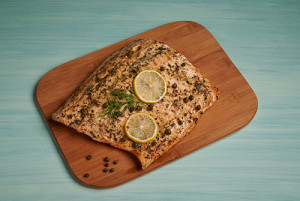Fish: A Food for Your Menu All Year Round
Has fish been on your menu lately? A few months have passed since the Lent season, when many people may have found themselves eating fish much more frequently than other times of the year. Even those who do not celebrate Lent may have eaten more fish while they were highly marketed, prices were cut, and restaurants offered specials on fish dishes. Well, I am here to encourage you about the many nutritional benefits of fish and why to keep eating it all year round.
Consider the following abundant list of conditions and diseases that fish intake may help improve: acne, Alzheimer’s disease, anemia, arthritis, asthma, cardiovascular disease, cataracts, Crohn’s Disease, insulin resistance, irritable bowel syndrome, macular degeneration, eczema, psoriasis, migraines, osteoporosis, and stress & anxiety. Are you affected by any of these conditions? If so, consider adding fish to your diet today!
Fish’s main component that is thought to contribute to these many health benefits is Omega-3 fatty acids. Omega-3 fatty acids contribute significantly to reducing inflammation in the body. As inflammation decreases, blood vessels open for better blood flow which decreases blood pressure, total and bad cholesterol levels are less likely to build up, and less blood clotting occurs which prevents strokes and heart attacks.
Along with fighting heart disease, the anti-inflammatory properties of fatty fish allow greater oxygen flow to all of the body’s tissues, providing comfort and relaxation in the gut, lungs, skin, eyes, and joints. This provides a more stable environment for the body to better battle with any inflammatory condition that can affect those areas. The especially high DHA (a form of omega-3) fatty acid content in fish is thought to significantly improve concentration, mental acuity, and memory. Another benefit of fish is the high vitamin E and zinc content which can assist in wound healing and improved skin integrity. Finally, the high selenium content in fish has been shown to provide cancer-fighting properties.
You might be wondering what type of fish is best to consume, especially if you are following a kidney diet. Fish can be generally categorized as either a finned fish (such as catfish, tilapia, or salmon) or shell fish (lobster, crabs, or clams). Almost any of these fishes are a rich source of protein (about 21 grams per 3 ounce serving), selenium, vitamin D, B vitamins, calcium, iron, zinc, vitamin E and magnesium. However, the omega-3 fatty acids are most highly concentrated in the fatty fin fish category.
Fatty fishes, which are usually more orange-red in color such as salmon, trout, mackerel, Albacore tuna, sardines, and herring, are top choices to include in your menus. Aim to include these in your meals twice a week. A three-ounce serving of fish (think the size of a deck of cards) is a healthy and safe serving size for someone with chronic kidney disease or end stage renal disease. Shell fish are not as rich in omega-3 fatty acids, but provide great sources of the other nutrients found in all types of fish.
The next time you plan a fish meal try one of my favorite fish recipes on  DaVita.com:
DaVita.com:
Fast and Flavorful Grilled Salmon
Additional Kidney Diet Resources
Visit DaVita.com and explore these diet and nutrition resources:
DaVita Kidney-Friendly Recipes
This article is for informational purposes only and is not a substitute for medical advice or treatment. Consult your physician and dietitian regarding your specific diagnosis, treatment, diet and health questions.

Recent Comments